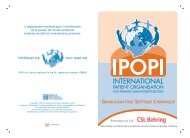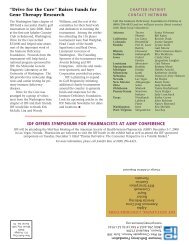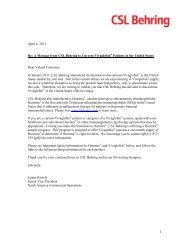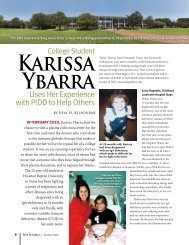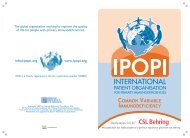IDF Patient & Family Handbook for Primary Immunodeficiency ... - IDFA
IDF Patient & Family Handbook for Primary Immunodeficiency ... - IDFA
IDF Patient & Family Handbook for Primary Immunodeficiency ... - IDFA
Create successful ePaper yourself
Turn your PDF publications into a flip-book with our unique Google optimized e-Paper software.
56<br />
Ataxia Telangiectasia<br />
Diagnosis of Ataxia Telangiectasia<br />
The diagnosis of Ataxia Telangiectasia (A-T) is<br />
usually based on characteristic clinical findings<br />
and supported by laboratory tests. Once all of<br />
the clinical signs and symptoms of A-T have<br />
become obvious in an older child or young adult,<br />
the diagnosis is relatively easy. The most difficult<br />
time to diagnose A-T is during the period when<br />
neurologic symptoms are first apparent (early<br />
childhood) and the typical telangiectasia has<br />
not yet appeared. During this period, a history<br />
of recurrent infections and typical immunologic<br />
findings can be suggestive of the diagnosis. One<br />
of the most helpful laboratory tests used to assist<br />
in the diagnosis of A-T is the measurement of<br />
alpha-fetoprotein levels in the blood. This is a<br />
protein that is usually produced only during fetal<br />
development but may persist at high blood levels<br />
in some conditions (such as A-T) after birth. The<br />
vast majority of A-T patients (>95%) have elevated<br />
levels of serum alpha-fetoprotein. When other<br />
causes of elevations of alpha-fetoprotein are<br />
eliminated, elevated alpha-fetoprotein in the blood,<br />
in association with the characteristic signs and<br />
symptoms, makes the diagnosis of A-T a virtual<br />
certainty.<br />
Other diagnostic tests include:<br />
1. Detection of the protein (ATM) made by the A-T<br />
gene using a western blot<br />
2. Measurement of cellular damage (cell death or<br />
chromosomal breakage) after exposure of cells<br />
to x-rays in the laboratory<br />
3. Sequencing (reading the spelling) of the A-T<br />
gene (ATM)<br />
Inheritance of Ataxia Telangiectasia<br />
Ataxia Telangiectasia is inherited as an autosomal<br />
recessive disorder (see chapter titled Inheritance).<br />
The gene responsible <strong>for</strong> A-T has been identified<br />
and is found on the long arm of chromosome<br />
11 at 11q22-23. It controls the production of<br />
a phosphatidylinositol-3-kinase-like enzyme<br />
involved in cellular responses to stress, DNA<br />
damage and cell cycle control. The identification<br />
of the specific gene responsible <strong>for</strong> A-T has made<br />
carrier detection and prenatal diagnosis possible,<br />
though it can be done only in a few specialized<br />
laboratories and is very expensive.<br />
General Treatment <strong>for</strong> Ataxia Telangiectasia<br />
There is no cure <strong>for</strong> any of the problems in<br />
Ataxia Telangiectasia (A-T), and treatment is<br />
largely supportive. <strong>Patient</strong>s of all ages should be<br />
encouraged to participate in as many activities<br />
as possible. Children should be able to attend<br />
school on a regular basis, but most will eventually<br />
need full-time classroom aides. Progressive eye<br />
movement abnormalities make reading difficult,<br />
but listening skills do not deteriorate. As a result,<br />
it is helpful to introduce books-on-tape at a young<br />
age to foster development of listening skills.<br />
Computers are also helpful learning aides that<br />
can be easily adapted to the specific needs of an<br />
individual who has problems with eye and hand<br />
coordination. Physical and occupational therapists<br />
should be included in the treatment team to<br />
prevent the development of stiffness in muscles<br />
and to maintain functional mobility.<br />
A prompt diagnosis should be sought <strong>for</strong> all<br />
suspected infections and specific therapy<br />
instituted. For patients who have normal levels<br />
of serum immunoglobulins and normal antibody<br />
responses to vaccines, immunization with<br />
influenza (flu) and pneumococcal vaccines may be<br />
helpful. For patients with total IgG, or IgG subclass<br />
deficiencies, and/or patients who have problems<br />
making normal antibody responses to vaccines,<br />
immunoglobulin replacement therapy may be<br />
indicated. In an ef<strong>for</strong>t to decrease exposure to the<br />
flu, all household members should receive the flu<br />
vaccine every fall.








